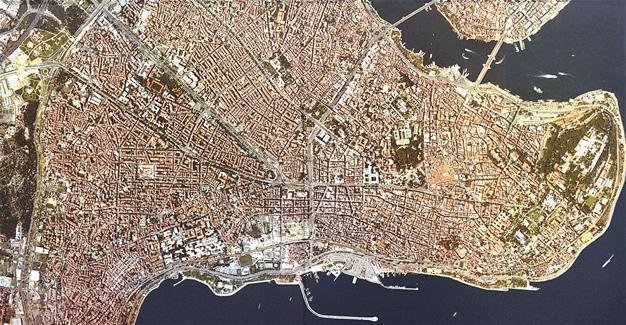Bypass on historic peninsula spark debate
ISTANBUL - Fatma Aksu

A new decision by the Istanbul Metropolitan Municipality Council has sparked debate on the restoration, reinforcement and maintenance projects of around 50,000 buildings located on the city’s historic peninsula, which are situated on around 10,000 registered architectures. The decision said it will no longer seek for the approval of the Cultural and Natural Heritage Conservation Board.
The decision is related to 50,000 buildings around 10,000 registered historical architectures and will pave way for the restoration of buildings and new investments in the Fatih neighborhood.
According to the new regulation, registered structures on the archaeological site and in first-, second- and third-degree protected areas will be evaluated by the Conservation Board as they were before. But the other structures around the registered ones will be evaluated directly by the municipality.
Taking into consideration the architectural character of the structures on these areas, the district municipality will make restorations without damaging the historical tissue of the buildings.
The head of the Reconstruction Committee, Hadi Diler from the ruling Justice and Development Party, said changes were made in accordance with the Culture and Tourism Ministry General Directorate of Museum’s decision on the establishment of the Directorate for the Inspection of Conservation Implementations (KUDEB) in the areas of old artifacts and archaeological sites.
“The decision will be evaluated by the Council of Monuments and will be put into force when it is approved by the council,” Diler said.
Esin Hacıalioğlu, a deputy from the Republican People’s Party and a member of the municipality, said the decision was unlawful.
“You need to approach the historic peninsula as a whole. It cannot be evaluated by the council and the municipality in two parts,” she said.
‘We have KUDEB’
The mayor of Fatih, Mustafa Demir, said the projects regarding land parcels located around registered architectures will be made by KUDEB, which has been established under the municipality with the participation of architects, city planners and archaeologists, who are trained in conservation boards and somehow take charge of board members.
“Now we have KUDEB instead of the Conservation Board,” he added.
Demir said that in reconstruction plans for protection, known as the “City Constitution,” the number of floors in buildings is apparent, and the regulation would pave way for investments on the historic peninsula at a time of economic recession.
He said Fatih was home to 10,000 registered architectures and 50,000 unregistered ones around them.
“The projects related to the unregistered architectures used to be evaluated by the Conservation Board because they are close to the registered ones. A project used to be evaluated by the board in three years at least. No investment was made in Fatih because it was impossible to do anything without the board’s approval. At a time of economic recession, we want to invite investors to Fatih. We are ready to support them on every issue,” he added.
City planners say it is illegalSpeaking about the issue, the Union of Chambers of Turkish Engineers and Architects (TMMOB) Istanbul Branch Secretary Akif Burak Atlar said “The Conservation Board is asked to be deactivated with this change.
In accordance with the Code of the Cultural and Natural Heritage Preservation, the Conservation Board is authorized even in the land parcels of the unregistered architectures around the registered ones. The change in plan was made contradictorily to the Code of the Cultural and Natural Heritage Preservation.”
 A new decision by the Istanbul Metropolitan Municipality Council has sparked debate on the restoration, reinforcement and maintenance projects of around 50,000 buildings located on the city’s historic peninsula, which are situated on around 10,000 registered architectures. The decision said it will no longer seek for the approval of the Cultural and Natural Heritage Conservation Board.
A new decision by the Istanbul Metropolitan Municipality Council has sparked debate on the restoration, reinforcement and maintenance projects of around 50,000 buildings located on the city’s historic peninsula, which are situated on around 10,000 registered architectures. The decision said it will no longer seek for the approval of the Cultural and Natural Heritage Conservation Board.